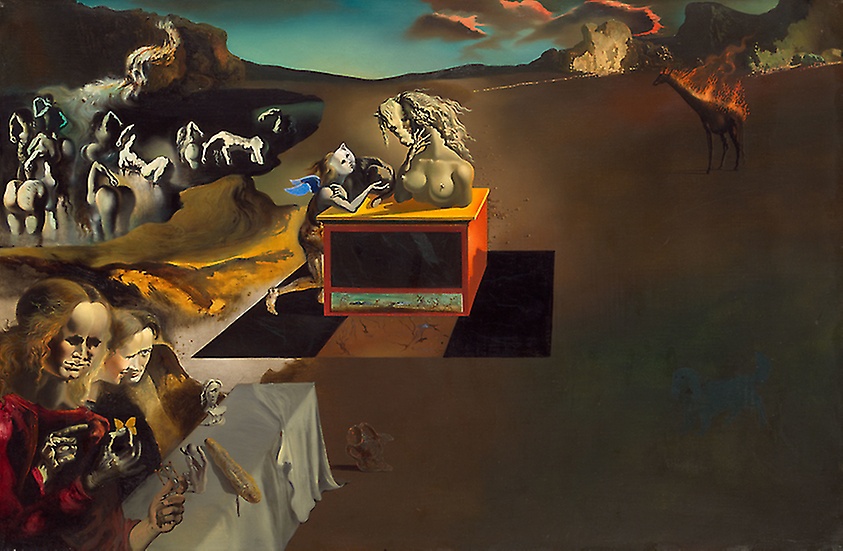The artwork under consideration is the painting by Salvador Dali entitled Inventions of the Monsters (1937). The medium is oil on canvas, and the dimension is 51.4×78.4 cm (Art Institute of Chicago, 2018). The artist depicts a clear terrain with rocky mountains in the background.

There is also a burning giraffe and a blue dog on the right, horse-women in the river on the left, and a box with a bust and a monster figure in the center. Dali himself, his Gala, and a monster are sitting at a table in the foreground.
The painting is a conspicuous illustration of such an art movement as surrealism. The artist depicts symbolic images linked to the domain of subconsciousness. Dali combines a realistic depiction of specific objects of the physical world (a giraffe, human figures, rocks) with unrealistic dreams (women horses, the monster beside Dali and Gala). The artwork is painted in deep colors, and dark shades prevail.
The background is painted in warmer and gloomy tinges. The blue dog is not easily decipherable and displayed in greyish shades. The composition of the piece seems unbalanced, but since it is a surrealistic work, this disproportion is likely to convey some meaning. Dali overcrowds the left part of the painting with objects and images, while the right half is almost empty, which adds confusion and a sense of a surrealistic picture of the world.
Similar to any other surrealistic artwork, the painting in question has some comments of the artist that help to decipher its meaning. Dali noted that the piece had been created several months before the Anschluss of Austria and had a “prophetic character” (as cited in Art Institute of Chicago, 2018, para. 2). The painting can be regarded as a manifestation of Dali’s fears regarding the future of Europe and the entire world that was ready to collapse into another war. The artist revealed his own nightmares regarding the war that was about to start.
The painting was created after the outburst of the war in Spain and the empowerment of the Nazis in Germany. The artist revealed the horror of those who could see the consequences of such events. The mother river symbolized the sorrow and despair of mothers who were to lose their children soon. Dali, his Gala, and the Death itself were ready to observe the horrible scene of the upcoming bloodshed. The artist shared his fears, trying to give specific shapes to his feelings. It is necessary to note that Salvador Dali was among hundreds of people who understood that the war was inevitable.
Although this painting is not the most famous or influential surrealistic artwork, it can definitely be seen as an illustration of the essence of the movement. Surrealism can be seen as a unification of the subconscious and conscious, the artist’s vision of the world, and some elements of reality (Cohen, 2015). Dali’s Inventions of the Monsters and other works contributed to the development of the movement as the artist exploited different techniques and imagery to exhibit the real world and the universe of his dreams.
Importantly, Dali managed to combine dreams and reality by transforming realistic images into symbols. The figures of women, the giraffe, the bust, and Gala or Dali are rather realistic, but they all stand for something more than mere physical objects. Dali was an influential artist who inspired other people to experiment and explore their creativity. Post-modern art formed on the basis of such works as the painting under analysis.
References
Art Institute of Chicago. (2018).Inventions of the Monsters. Web.
Cohen, G. M. (2015). Art history essentials. Research & Education Assoc.